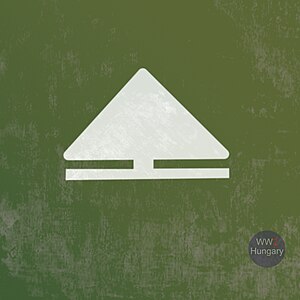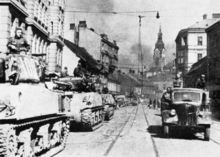7th Mechanized Corps (Soviet Union)
| 7th Mechanized Corps | |
|---|---|
 Emblem of the 7th Mechanized Corps 1944-1945 | |
| Active | I Formation: 1934–1938 II Formation: 1940–1941 |
| Country | Mechanized corps |
| Engagements | World War II
|
| Decorations |
Order of Suvorov (3rd formation) |
| Battle honours | Novoukrainka (3rd formation) Khingan (3rd formation) |
| Commanders | |
| Notable commanders |
|
The 7th Mechanized Corps was a
History
First Formation
The corps (
Second Formation
The corps (Military Unit Number 6850) began forming on 8 July 1940 in the Moscow Military District from the 39th and 55th Light Tank Brigades, and the 1st Motorized Division. The corps headquarters was formed from that of the 57th Rifle Corps. The 14th Tank Division was formed from the 55th Light Tank Brigade and the 18th Tank Division from the 39th Light Tank Brigade. The final prewar locations of the units were: Corps headquarters at Moscow, 14th Tank Division at Naro-Fominsk (Summer camp at Kubinka), 18th Tank Division at Kaluga, the 1st Motorized Division at Moscow (Summer camp at Alabino). The corps was commanded by Major General Vasily Vinogradov.[2]
On 22 June, the German invasion of the Soviet Union,

By the time it went into battle, the strength of the corps had been reduced to 428 tanks due to breakdowns. The corps attacked without air support, and with a shortage of fuel, ammunition, and anti-aircraft guns. The 5th Mechanized Corps stopped its advance due to fuel shortages.
The corps was subordinated to the
Third Formation
The corps was reformed between 1 August and 30 September 1943 near
During March and April 1944, the corps fought in the
During the offensive it crossed the Prut. On 22 August it was thanked by Stavka for breaking through heavily fortified defenses south of Bender and capturing Căușeni, Cimișlia, and Tarutyne. In early September, the corps fought in the capture of Romania and Bulgaria. On 9 September the corps received the Order of Suvorov 2nd class for breaking through defenses south of Bender and helping to capture Chișinău. On the same day the corps was thanked by Stavka for occupying Shumen. From 6 to 28 October, the corps fought in the Battle of Debrecen.[16] The corps became part of the 2nd Ukrainian Front for the operation.[20] On 12 October, it captured Oradea, for which it received thanks from Stavka. On 20 October it helped capture Debrecen,[17] for which it received thanks from Stavka.[15]


From 29 October, the corps fought in the
Between 9 and 23 July 1945, the corps was relocated to Mongolia with the
Notes
- ^ Drig, Yevgeny. "7 механизированный корпус 10 танковый корпус" [7th Mechanized Corps 10th Tank Corps]. mechcorps.rkka.ru (in Russian). Archived from the original on 2012-11-02. Retrieved 25 August 2016.
- ^ a b c Drig, Yevgeny (6 January 2012). "7 механизированный корпус" [7th Mechanized Corps]. mechcorps.rkka.ru (in Russian). Archived from the original on 2012-11-05. Retrieved 25 August 2016.
- ^ Glantz 2010, p. 49.
- ^ a b Forczyk 2014, pp. 79–82.
- ^ Glantz 2010, p. 72.
- ^ Glantz 2010, pp. 71–75.
- ^ Glantz 2010, p. 97.
- ^ Glantz 2010, p. 79.
- ^ Glantz 2010, p. 87n88.
- ^ Glantz 2010, p. 121.
- ^ Glantz 2010, p. 169.
- ^ Glantz 2010, p. 200.
- ^ Glantz 2010, p. 233.
- ^ Glantz 2010, p. 243.
- ^ a b c d e f "7-й механизированный корпус" [7th Mechanized Corps]. www.tankfront.ru (in Russian). Retrieved 2016-08-26.
- ^ a b c d "Боевой путь" [Combat path]. 7mehkorpus.odessa.ua (in Russian). Retrieved 2016-08-26.
- ^ a b c d e "Освобождение городов" [Liberated cities]. 7mehkorpus.odessa.ua (in Russian). Retrieved 2016-08-26.
- ^ Glantz 2005, p. 307.
- ^ Glantz 2005, p. 413.
- ^ Glantz 2005, p. 443.
- ^ Ungvary 2006, p. 38.
- ^ Dunn 2009, p. 159.
- ^ Ungvary 2006, p. 198.
- ^ Glantz 2003, p. 20.
- ^ Glantz 2003, p. 164.
- ^ Glantz 2003, p. 165.
- ^ "36-я Забайкальская мотострелковая дивизия" [36th Transbaikal Motor Rifle Division]. rkka.ru (in Russian). Retrieved 28 August 2016.
- ^ Glantz 2003, p. 206.
- ^ Glantz 2003, p. 207.
- ^ Feskov et al 2013, pp. 211–212, 219.
- ^ Feskov et al 2013, pp. 204–205.
References
- Dunn, Walter S. (2009). Hitler's Nemesis: The Red Army, 1930-45. Mechanicsburg, Pennsylvania: Stackpole. ISBN 9781461751151.
- Feskov, V.I.; Golikov, V.I.; Kalashnikov, K.A.; Slugin, S.A. (2013). Вооруженные силы СССР после Второй Мировой войны: от Красной Армии к Советской [The Armed Forces of the USSR after World War II: From the Red Army to the Soviet: Part 1 Land Forces] (in Russian). Tomsk: Scientific and Technical Literature Publishing. ISBN 9785895035306.
- Forczyk, Robert (2014). Tank Warfare on the Eastern Front 1941–1942: Schwerpunkt. Barnsley, South Yorkshire: Pen & Sword. ISBN 9781781590089.
- Glantz, David M. (2003). The Soviet Strategic Offensive in Manchuria, 1945: 'August Storm'. London: Frank Cass. ISBN 9781135774998.
- Glantz, David M. (2005) [1989]. Soviet Military Deception in the Second World War (Digital ed.). London: Frank Cass. ISBN 978-0714633473.
- Glantz, David M. (2010). Barbarossa Derailed: The German Advance to Smolensk, the Encirclement Battle, and the First and Second Soviet Counteroffensives, 10 July – 24 August 1941. Philadelphia: Casemate. ISBN 9781906033729.
- Ungvary, Krisztian (2006) [2003]. The Siege of Budapest: One Hundred Days in World War II. Translated by Ladislaus Lob. New Haven, Connecticut: Yale. ISBN 9780300119855.
Further reading
- Dickson, Gary A. (6 June 2013). "The Counterattack of the 7th Mechanized Corps, 5–9 July 1941". S2CID 144555553.
- Pogrebnoy, Sergei (1989). Лавиной стали и огня: Военно-исторический очерк боевого пути 7-го механизированного Новоукраинского Хинганского ордена Ленина, Краснознаменного, ордена Суворова корпуса [Avalanche of Steel and Fire: Military-Historical Sketch of the Combat Path of the 7th Mechanized Novoukrainka-Khingan Order of Lenin, Red Banner, Order of Suvorov Corps] (in Russian). Moscow: Voenizdat. ISBN 978-5203003089.
